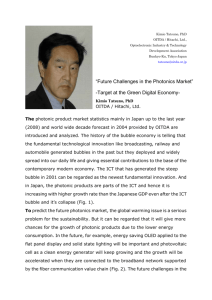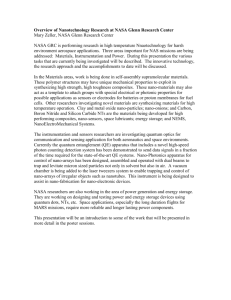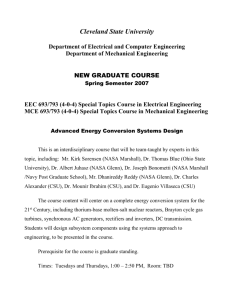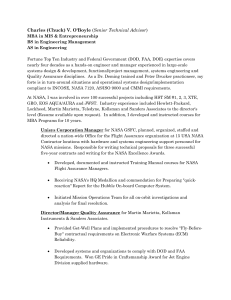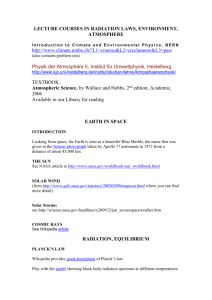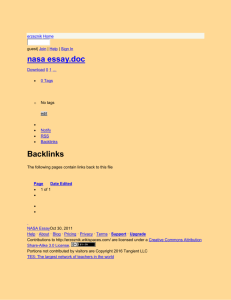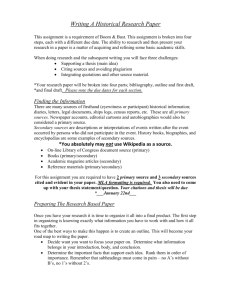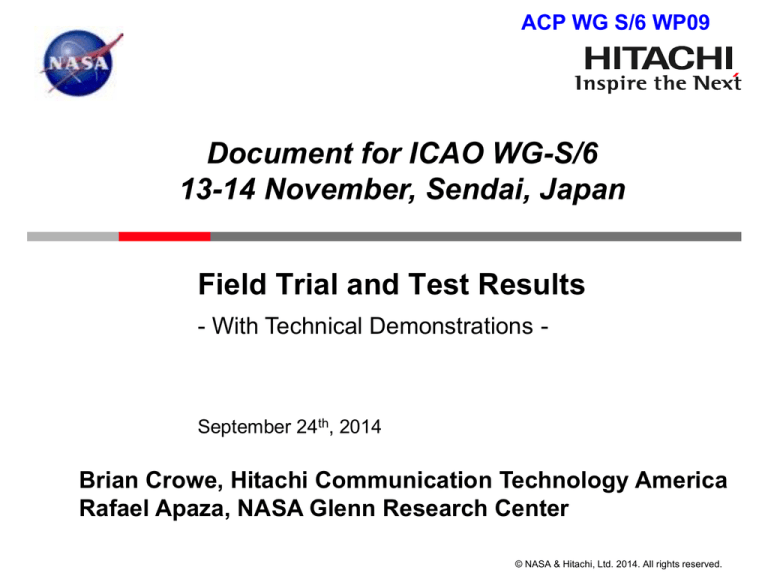
ACP WG S/6 WP09
Document for ICAO WG-S/6
13-14 November, Sendai, Japan
Field Trial and Test Results
- With Technical Demonstrations -
September 24th, 2014
Brian Crowe, Hitachi Communication Technology America
Rafael Apaza, NASA Glenn Research Center
© NASA & Hitachi, Ltd. 2014. All rights reserved.
Contents
1. Outline of Field Trial Results
2. Test Items and Results
3. Security
4. Future Work
© NASA & Hitachi, Ltd. 2014. All rights reserved.
1
1. Outline of Field Trial Results
© NASA & Hitachi, Ltd. 2014. All rights reserved.
2
1.1 Outline of the Field Trial Tests
1.Purpose of the Tests
a. Research and evaluate AeroMACS MOPS (Minimum Operational Performance
Standards) compliant products utilizing the NASA CNS Test-bed
b. Develop recommendation for ICAO (International Civil Aviation Organization)
/SARPs(Standards And Recommended Practices) standardization for safety of
flight applications of a wireless communications network on the airport surface
that includes both mobile and fixed elements
c. Characterize and analyze path loss in the airport environment and evaluate
potential interference with uplinks to mobile satellite systems
2.Testing Parties: NASA Glenn Research Center, Hitachi, Ltd. & HCTA, Inc.
3.Testing Schedule: April 14, 2014 – July 31, 2014
4.Testing Locations
a. Cleveland Hopkins International Airport (CLE)
b. NASA Glenn Research Center(GRC) Building110
5.Outline of Results
a. Planned test items were all completed with satisfactory data on basic
performance such as throughput (MIMO-A/B), path loss and mobility (incl.
Handover) in the real airport environment.
b. Test data analysis is now in process, and the final report will be presented at
the next ICNS meeting in April 2015.
NASA/Hitachi Confidential Proprietary
© NASA & Hitachi, Ltd. 2014. All rights reserved.
3
1.2 Area Map and BS/SS Deployment
MS
INE point
GRC/B110
SS
CMF
(1,585m)
SS
Terminal C
(448m)
BS#1~3
ARFF
MS
MS
ARFF2 ARFF1
SS
ALSF
(2,748m)
NASA/Hitachi Confidential Proprietary
© NASA & Hitachi, Ltd. 2014. All rights reserved.
4
1.3 Field Trial Test Items
Test items covering the following five categories of testing are a
“World’s 1st” from the standpoint of comprehensiveness.
1. Initial Network Entry Test
2. Throughput Test
3. QoS Test
4. Mobility Test
5. Long Term Stability Test
NASA/Hitachi Confidential Proprietary
© NASA & Hitachi, Ltd. 2014. All rights reserved.
5
1.4 Field Trial Schedule
Month
Milestone
April
May
Equipment
Brought In
June
July
Kickoff
August
September
October
DEMO
Equipment
Shipping
WiMAX Aviation
2014@Sendai
WiMAX Aviation
2014@Brussel
Events
November
Laboratory
Installation
Laboratory Test
Field Deployment
Area Optimization
Field Trial
Schedule
Field Trial Tests
Test Results Analysis
Application Development
Additional Tests
Un-installation
NASA/Hitachi Confidential Proprietary
© NASA & Hitachi, Ltd. 2014. All rights reserved.
6
2. Test Items and Results
2.1
2.2
2.3
2.4
2.5
Initial Network Entry Test
Throughput Test
QoS Test
Mobility Test
Long Term Stability Test
© NASA & Hitachi, Ltd. 2014. All rights reserved.
7
2.1 Initial Network Entry Test (1/3)
2.1.1 Objectives of the Tests
To validate and prepare recommendations for SARPs(ICAO)
2.1.2 Test Configuration
(1) Initial Network Entry (INE) in single
BS environment
BS#1
Subscriber
Station
(a) 5100MHz Fixed
(b) 5 MHz Step
(c) 250 kHz Step
Single Board
Computer
(2) INE in Multiple BS Environment
Freq. 5100MHz 5120MHz
RSSI -88dBm
-90dBm
CINR
1dB
9dB
(3) INE in driving condition on the Runway
@ 50 knot
BS#1
Mobile
Station
BS#2
BS#3
Laptop
Computer
NASA/Hitachi Confidential Proprietary
(a)
(b)
BS#1
5125MHz
-84dBm
15dB
BS#2
Mobile
Station
(a)
(b)
BS#3
Laptop
Computer
5 MHz Step
250 kHz Step
5 MHz Step
250 kHz Step
© NASA & Hitachi, Ltd. 2014. All rights reserved.
8
2.1 Initial Network Entry Test (2/3)
Definition of Initial Network Entry
MS to scan for DL channel
T1
MS to select best channel to synchronize
Scan
MS to synchronize to DL of BS
Sub INE time: T1
This depends on the MS implementation.
T2
Ranging & Automatic adjustments
RNG
Negotiate basic capabilities between MS and BS
SBC
Authentication for entering network
PKM
MS registration to network
REG
Sub INE time: T2
This depends on the environment around MS and BS.
Definition of T1 and T2
Both were proposed by Hitachi and approved by ICAO.
Establish IP connectivity
DSA
Dynamic Service Flow establishment
Operational data exchange
NASA/Hitachi Confidential Proprietary
© NASA & Hitachi, Ltd. 2014. All rights reserved.
9
2.1 Initial Network Entry Test (3/3)
2.1.3 Test Results
Average Initial Network Entry time (Terminal C)
30
Time [sec]
25
7%
20
15
93%
10
5
0
DSA
REG
PKM
SBC
RNG
Scan
Number of Scan
Points
Scan Time/
Number of scan
points
Fixed
0.27
0.13
1.20
0.16
0.14
T1= 0.16
T2
=1.90
5000kHz Step
0.27
0.13
1.18
T2
0.14
=1.86
0.14
T1= 1.25
250kHz Step
0.30
0.11
1.22
T2
0.09
=1.86
0.14
T1= 23.65
1
11
201
0.16
0.11
0.12
* 250kHz scan step is the standard value defined in SARPs.
NASA/Hitachi Confidential Proprietary
© NASA & Hitachi, Ltd. 2014. All rights reserved.
10
Demonstration Time!
1. Initial Network Entry
a. Scan Range and Steps
b. Manual and Automatic
c. Network Entry
i. Fixed
ii. 5 MHz Step
iii. 250 kHz Step
NASA/Hitachi Confidential Proprietary
© NASA & Hitachi, Ltd. 2014. All rights reserved.
11
2.2 Throughput Test (1/4)
2.2.1 Objectives of the Test
a.
b.
c.
d.
To evaluate the basic performance of BS/SS/MS in a real airport environment
To obtain path loss data
To validate the Technical Standard (i.e. Downlink/Uplink Ratio)
To investigate the applicability of MIMO-A/B
2.2.2 Test Configuration (Ref. p.14 of “NASA/Hitachi AeroMACS Test-bed” for details)
Downlink Traffic in UDP/iperf, 10-20 Mbps
Application
Server
Home Agent
ASN-GW
Base Station
Subscriber
Station
Single Board
Computer
Uplink Traffic in UDP/iperf, 5 Mbps
NASA/Hitachi Confidential Proprietary
© NASA & Hitachi, Ltd. 2014. All rights reserved.
12
2.2 Throughput Test (2/4)
AeroMACS
TDD Frame = 5 msec
Total = 47 Symbols
2.2.3 Test Items
(1) Single MS/SS Peak Throughput:
7 x 4 x 3 = 84 combinations
BS
- Location Parameters (7 cases)
Basic Performance
MS/SS
26
21
29
18
32
15
35
12
Downlink
Symbols
MS/SS
BS
Uplink
Symbols
Hitachi Laboratory (1)
Vicinity of Base Stations (near ARFF), per Base Station (3)
Path Loss Effect (Term-C, CMF and ALSF, (3))
- Downlink : Uplink Symbol Ratio (26:21, 29:18, 32:15, 35:12, (4 cases)
- Type of Link (Downlink MIMO-A, Downlink MIMO-B and Uplink, (3 cases))
(2) Round Trip Time: 7 x 4 x 3 = 84 combinations
- Same as above
(3) Multiple MS/SS Sector Throughput: 4 x 4 x 3 = 48 combinations
- Same as above except for excluding Path Loss Effect
- Number of MS = 10 (Hitachi Lab.), 2 (Field Trial)
NASA/Hitachi Confidential Proprietary
© NASA & Hitachi, Ltd. 2014. All rights reserved.
13
2.2 Throughput Test (3/4)
2.2.4 Single MS/SS Peak Throughput Test Results
(1) BS Basic Capability (Single SS/MS Peak Throughput)
(UDP, iperf, BW=5MHz, unit:Mbps)
No.
Link identification
26:21
29:18
32:15
35:12
MIMO-A
6.1
7.3
8.3
9.2
MIMO-B*
11.7
14.9
16.6
19.1
4.7
3.9
3.1
2.3
1
2
3
Downlink
Downlink : Uplink Symbol Ratio
Uplink
*option
Note) What is MIMO (Multiple Input and Multiple Output)?
Receiver
A-1
A
A
A
Receiver
Rx Antenna Diversity
[AeroMACS Uplink]
NASA/Hitachi Confidential Proprietary
Transmitter
Transmitter
Transmitter
Transmitter
A
B
Receiver
Receiver
MIMO-A
(Space Time Coding)
MIMO-B
(Spatial Multiplexing)
© NASA & Hitachi, Ltd. 2014. All rights reserved.
14
2.2 Throughput Test (4/4)
(2) Path Loss Effect (Single SS/MS Peak Throughput, UDP/iperf)
(Mbps)
10
9
8
7
Downlink
MIMO-A
6
Hitachi Lab.
5
Term-C
4
CMF
3
ALSF
2
1
0
26:21
29:18
32:15
35:12
No.
SS Site
Distance to ARFF
DL CINR (dB)
MCS
1
Term-C
448m
28
64QAM-5/6
2
CMF
1585m
24
64QAM-5/6
3
ALSF
2748m
21
64QAM-2/3
NASA/Hitachi Confidential Proprietary
© NASA & Hitachi, Ltd. 2014. All rights reserved.
15
Demonstration Time!
1. EFB Application (Weather Information Access)
2. Pilot – Tower Communication (VoIP)*
* an optional future capability
3. Airport Surveillance Camera
(@Laboratory R310)
NASA/Hitachi Confidential Proprietary
© NASA & Hitachi, Ltd. 2014. All rights reserved.
16
EFB Application (Weather Information Access)
Weather information
- Simulating gathering weather information from “WSI Pilotbrief Optima” site to EFB via
AeroMACS network.
AAA
MS
BS
ASN-GW
HA
DNS
NAT
server
Network
WSI weather information to EFB
WiFi
router
Tablet
Pilot
EFB
WSI site
WSI: Weather Services International
EFB: Electronic Flight Bag
NASA/Hitachi Confidential Proprietary
© NASA & Hitachi, Ltd. 2014. All rights reserved.
17
Pilot – Tower Communication (VoIP)
Voice over IP (an optional future capability)
- Simulating a communication between control tower and aircraft using Skype.
AAA
MS
BS
ASN-GW
HA
DNS
NAT
server
Network
Directions from control tower to aircraft
WiFi
router
Laptop
Tablet
Ground controller
Pilot
NASA/Hitachi Confidential Proprietary
© NASA & Hitachi, Ltd. 2014. All rights reserved.
18
Airport Surveillance Camera
Video surveillance
- Simulating airport surveillance video between web camera and monitoring center.
AAA
SS
BS
ASN-GW
HA
Surveillance video from web camera to monitoring center
Web
camera
Laptop
Runway/Taxiway
Monitoring center
NASA/Hitachi Confidential Proprietary
© NASA & Hitachi, Ltd. 2014. All rights reserved.
19
2.3 QoS Test (1/3)
2.3.1 What is QoS?
QoS serves for scheduling of the data transfer through QoS-enabled Service Flows
according to the established QoS traffic parameters.
No.
Application Example
(IEEE802.16/MASPS)
Name
Meaning
Application
1
UGS
Unsolicited Grant
Service
Real-time data with fixed-data-rate
- E1/T1 transport
- Circuit switched voice
- VoIP without silence suppression
2
rtPS
Real-Time Polling
Service
Real-time data with variable-bit-rates which
require guaranteed data rate and delay
MPEG Video
3
nrtPS
Non-Real-Time
Polling Service
Guaranteed data rate but insensitive to
delays
FTP
4
BE
Best Effort Service
No rate or delay requirements
HTTP
5
ertPS
Extended-Real-Time
Polling Service
Real-time data with variable-data-rate which
require guaranteed data and delay
VoIP with silence suppression
2.3.2 Objectives of the Tests
To verify the Technical Standard (Network)
To validate that a single SS/MS accommodates multiple QoS class communication
links
NASA/Hitachi Confidential Proprietary
© NASA & Hitachi, Ltd. 2014. All rights reserved.
20
2.3 QoS Test (2/3)
2.3.3 Test Configuration: How to establish Multiple Service Flows(SF)
< Definition of Service Flows >
SBC/SS
BS/ASN-GW/HA
APP
Server
Service Flow #1
Downlink: BE
Service Flow #3
Downlink: UGS
Service Flow #2
Uplink: BE
Service Flow #4
Uplink: UGS
< Description in AAA Configuration file based on WMF Network Architecture>
QoS Class is assigned onto port numbers per IP Address (SS/MS) in the AAA configuration file
<IP Address> <Port Number> <QoS Class> <Direction>
Example for upper case
<IP Address of SS> < Port Number =5001> <BE> <Downlink>
<IP Address of APP Server> < Port Number = 5002> <BE> <Uplink>
<IP Address of SS> < Port Number =5003> <UGS> <Downlink>
<IP Address of APP Server> < Port Number = 5004> <UGS> <Uplink>
NASA/Hitachi Confidential Proprietary
© NASA & Hitachi, Ltd. 2014. All rights reserved.
21
2.3 QoS Test (3/3)
2.3.3 Test Items
(1) Multiple Service Flows (4SF) for Single MS/SS: 8 combinations
(2) Multiple Service Flows for Multiple MS/SS
(a) 4 SFs for 2 MS/SS that are connected to
DL CINR
[dB]
the same BS: 8 combinations
(b) 6 SFs for 2 MS/SS that are connected to 30
28
the same BS: 8 combinations
26
2.3.4 Test Result Example:
2.3.3(1) UGS + BE (DL)
24
UL Throughput
22
[Mbps]
3
20
180
BE data start
240
300
360
420
Time [sec]
BE data end
UL Packet Error Rate
[%]
2
UGS
BE
1
16
14
12
High PER (1)
- BE: 8.47 %
- UGS: 0 %
High PER (2)
- BE: 15 %
- UGS: 0 %
High PER (3)
- BE: 11.17 %
- UGS: 0 %
10
UGS
8
BE
6
0
0
60
120 180 240 300 360 420 480 540 600
Time [sec]
* UL data of UGS is always transferred using QPSK-1/2
which is the most robust MCS class. This is the original
design of Hitachi AeroMACS prototype.
NASA/Hitachi Confidential Proprietary
480
4
2
0
180
240
300
360
420
480
Time [sec]
© NASA & Hitachi, Ltd. 2014. All rights reserved.
22
QoS Validation
Quality of Service
SS#3
AAA
Laptop#3
Iperf data (5Mbps from each SS)
QoS class: BE
SS#2
BS
ASN-GW
HA
Laptop#2
Iperf data (0.2Mbps)
QoS class: UGS
Streaming data
QoS class: BE
SS#1
Laptop#1
UGS data transmitting from SS#1 to Laptop#2 is guaranteed
during other big BE data is transmitting.
BE: Best Effort
UGS: Unsolicited Grant Service
NASA/Hitachi Confidential Proprietary
© NASA & Hitachi, Ltd. 2014. All rights reserved.
23
Demonstration Time!
1. QoS Validation (Video Demo)
2. QoS Demonstration (@Laboratory R310)
NASA/Hitachi Confidential Proprietary
© NASA & Hitachi, Ltd. 2014. All rights reserved.
24
2.4 Mobility Test (1/3)
2.4.1 Objectives of the Tests
To identify the area where AeroMACS communication is available
To obtain Path Loss data by measuring the radio field of the airport
To demonstrate handover between base stations in a real airport environment
2.4.2 Test Configuration
(1) Path Loss Measurement &
CINR/RSSI Distribution Map
Generation
(2) Handover Performance on Runway &
Peak Throughput at Driving Condition
@ 50 knot
With neighbor information
Without neighbor information
BS#1
Mobile
Station
BS#2
BS#3
Laptop
Computer
NASA/Hitachi Confidential Proprietary
BS#1
Mobile
Station
BS#2
Laptop
Computer
© NASA & Hitachi, Ltd. 2014. All rights reserved.
25
2.4 Mobility Test (2/3)
Handover on the Runway: Southwestward
Handover
Point
Handover
Point
BS#1&BS#2
Handover: Success (Controlled Handover) @ Runway 24L/24R
Speed: >50 knot
Direction: Southwestward
Handover Latency: 160 – 200 msec.
NASA/Hitachi Confidential Proprietary
© NASA & Hitachi, Ltd. 2014. All rights reserved.
26
2.4 Mobility Test (3/3)
Handover on the Runway: Northeastward
Handover
Point
Handover
Point
BS#1&BS#2
Handover: Success (Controlled Handover) @ Runway 6R/6L
Speed: >50 knot
Direction: Northeastward
Handover Latency: 160 – 200 msec.
NASA/Hitachi Confidential Proprietary
© NASA & Hitachi, Ltd. 2014. All rights reserved.
27
Handover on the Runway (CLE)
Handover (Pre-recorded)
AAA
BS#1
BS#2
ASN-GW
HA
Handover
MS
MS
50 knot
Runway
Controlled Handover is successfully executed from BS#1 to BS#2
during running at 50 knot on runway.
NASA/Hitachi Confidential Proprietary
© NASA & Hitachi, Ltd. 2014. All rights reserved.
28
Demonstration Time!
1. Handover on the Runway (CLE)
NASA/Hitachi Confidential Proprietary
© NASA & Hitachi, Ltd. 2014. All rights reserved.
29
2.5 Long Term Stability Test (1/4)
2.5.1 Objectives of the Tests
To verify BS Holdover functionality after Loss of GPS Signal
To check the blockage of the wireless communication link by the airplane
To obtain Rain/Fog/Snow attenuation effect data
To check the stability of the system working in a real airport environment
2.5.2 Test Items
(1) BS Frequency & Time Stability without GPS Signal
(2) Blockage Effects by Airplanes
(3) Rain Attenuation
(4) Interference between Adjacent Channels using Different DL:UL Symbol Ratios
(5) Observation of System Performance
NASA/Hitachi Confidential Proprietary
© NASA & Hitachi, Ltd. 2014. All rights reserved.
30
2.5 Long Term Stability Test (2/4)
2.5.3 Test Results
(1) BS Frequency & Time Stability without GPS Signal
1000
1 PPS Interval Error
[nsec]
Frequency Error [Hz]
200
100
500
0
0
-500
-100
-1000
-200
0
4
8
12
16
20
Time after loss of GPS [hours]
Frequency error was maintained
within 100 Hz for 24 hours.
NASA/Hitachi Confidential Proprietary
24
0
4
8
12
16
20
24
Time after loss of GPS [hours]
Timing Offset was maintained
within 400 ns for 24 hours.
© NASA & Hitachi, Ltd. 2014. All rights reserved.
31
2.5 Long Term Stability Test (3/4)
Video
Surveillance
Started
B737@24R
B737@Golf
B737@24R
B737@Kilo
B737@Kilo
BS (@ARFF)
E190@24R
E190@Golf
CRJ700@24R
CRJ700@24R
View from SS (@CMF)
NASA/Hitachi Confidential Proprietary
© NASA & Hitachi, Ltd. 2014. All rights reserved.
32
2.5 Long Term Stability Test (4/4)
(2) Blockage Effects by Airplanes between ARFF and CMF
Video
Surveillance
Started
B737@24R
B737@Kilo
B737@Golf
BS (@ARFF)
B737@24R
B737@Kilo
E190@24R
View from SS (@CMF)
NASA/Hitachi Confidential Proprietary
E190@Golf
CRJ700@24R
CRJ700@24R
© NASA & Hitachi, Ltd. 2014. All rights reserved.
33
3. Security
© NASA & Hitachi, Ltd. 2014. All rights reserved.
34
3. Security Results
3.1 Hitachi SS’s access to Alvarion BS
Hitachi Mobile Station (when it was located near ARFF) found Alvarion BS
after scan at the INE as the most favorable one
It tried to enter the network via Alvarion BS but couldn’t do so because the
Alvarion AAA rejected.
.
3.2 Alvarion SS’s access to Hitachi BS
Alvarion Subscriber Station found Hitachi BS after scan (the output power
of the Alvarion BS is now lowered to 1dBm).
It is still trying to enter the network via Hitachi BS but can’t do so because
Hitachi AAA keeps on rejecting.
NASA/Hitachi Confidential Proprietary
© NASA & Hitachi, Ltd. 2014. All rights reserved.
35
4. Future Work
© NASA & Hitachi, Ltd. 2014. All rights reserved.
36
4. Future Work
4.1 Tests Using Another Subscriber Station
Outdoor Type Subscriber Station is coming soon. Basic Performance will
be examined in the Airport environment.
.
4.2 Extended Tests with FAA
Details are under discussion
4.3 Final Report Presentation
Final Report will be presented at the next ICNS Conference in April 2015.
NASA/Hitachi Confidential Proprietary
© NASA & Hitachi, Ltd. 2014. All rights reserved.
37
Acronyms(1/2)
16QAM
64QAM
AAA
AeroMACS
ALSF
AM(R)S
APP
ASN
ARFF
ATC
BS
CLE
CMF
CSN
DL
DNS
EFB
ertPS
FAA
GPS
GRC
GW
HA
HCTA
ICAO
ICNS
NASA/Hitachi Confidential Proprietary
16 Quadrature Amplitude Modulation
64 Quadrature Amplitude Modulation
Authentication, Authorization and Accounting
Aeronautical Mobile Airport Communications System
Approaching Lights and Sequenced Flashing lights
Aeronautical Mobile satellite (Route) Service
Application
Access Service Network
Aircraft Rescue and Fire Fighting
Air Traffic Control
Base Station
Cleveland Hopkins International Airport
Consolidated Maintenance Facility
Connectivity Service Network
Downlink
Domain Name System
Electronic Flghit Bag
extended-real-time Polling Service
Federal Aviation Administration
Global Positioning System
Glenn Research Center (NASA)
Gateway
Home Agent
Hitachi Communication Technologies America, Inc.
International Civil Aviation Organization
integrated Communications, Navigation, and Surveillance
© NASA & Hitachi, Ltd. 2014. All rights reserved.
38
Acronyms(2/2)
INE
IP
MIMO
MS
MOPS
NASA
NAT
nrtPS
OFDMA
OMC
QoS
QPSK
rtPS
SARPs
SBC
SF
SM
SS
STC
TDD
UDP
UGS
UL
V.S.W.R
WMF
WSI
NASA/Hitachi Confidential Proprietary
Initial Network Entry
Internet Protocol
Multiple Input and Multiple Output
Mobile Station
Minimum Operational Performance Standards
National Aeronautics and Space Administration
Network Address Translation
non-real-time Polling Service
Orthogonal Frequency Division Multiple Access
Operation and Maintenance Center
Quality of Service
Quadrature Phase Shift Keying
real-time Polling Service
Standards And Recommended Practices
Single Board Computer
Service Flow
Spatial Multiplexing
Subscriber Station
Space Time Coding
Time Division Duplex
User Datagram Protocol
Unsolicited Grant Service
Uplink
Voltage Standing Wave Ratio
WiMAX Forum
Weather Services International
© NASA & Hitachi, Ltd. 2014. All rights reserved.
39
END
Field Trial and Test Results
September 24th, 2014
Toshihide Maeda, Hitachi, Ltd.
Rafael Apaza, NASA Glenn Research Center
William D. Ivancic, NASA Glenn Research Center
© NASA & Hitachi, Ltd. 2014. All rights reserved.
40
Backup Slides for Q&A
© NASA & Hitachi, Ltd. 2014. All rights reserved.
42
BS#1: RSSI
BS#1
BS#2
BS#3
NASA/Hitachi Confidential Proprietary
© NASA & Hitachi, Ltd. 2014. All rights reserved.
43
BS#2: RSSI
BS#1
BS#2
BS#3
NASA/Hitachi Confidential Proprietary
© NASA & Hitachi, Ltd. 2014. All rights reserved.
44
BS#3: RSSI
BS#1
BS#2
BS#3
NASA/Hitachi Confidential Proprietary
© NASA & Hitachi, Ltd. 2014. All rights reserved.
45
BS#1: CINR
BS#1
BS#2
BS#3
NASA/Hitachi Confidential Proprietary
© NASA & Hitachi, Ltd. 2014. All rights reserved.
46
BS#2: CINR
BS#1
BS#2
BS#3
NASA/Hitachi Confidential Proprietary
© NASA & Hitachi, Ltd. 2014. All rights reserved.
47
BS#3: CINR
BS#1
BS#2
BS#3
NASA/Hitachi Confidential Proprietary
© NASA & Hitachi, Ltd. 2014. All rights reserved.
48
Interference between Adjacent Channels
using Different Symbol Ratio
Case-1 (5MHz)
Case-2 (20MHz)
5095
NASA
BTS1-1
5100
5105
NASA
BTS2-1
BS#1
Case-1)
5 MHz
Separation
Case-2)
20 MHz
Separation
No.
5110
Not
Used
5115
NASA
BTS2-3
5120
5125
BS#2
BS#3
DL:UL Symbol Ratio
5130
NASA
BTS2-2
[MHz]
5135
NASA
BTS1-2
BS#2 (ALSF)
AeroMACS
TDD Frame = 5 msec
Total = 47 Symbols
26
21
29
18
32
15
35
12
Downlink
Symbols
Uplink
Symbols
BS#3 (CMF)
BS#2
BS#3
DL
UL
DL
UL
1
26:21
26:21
No Effect
No Effect
No Effect
No Effect
2
26:21
29:18
No Effect
No Effect
No Effect
No Effect
3
26:21
32:15
No Connection
No Connection
No Effect
No Effect
4
26:21
35:12
No Connection
No Connection
No Effect
No Effect
No.
DL:UL Symbol Ratio
BS#1 (Terminal-C)
BS#3 (CMF)
BS#2
BS#3
DL
UL
DL
UL
1
26:21
26:21
No Effect
No Effect
No Effect
No Effect
2
26:21
29:18
No Effect
No Effect
No Effect
No Effect
3
26:21
32:15
No Effect
No Effect
No Effect
No Effect
4
26:21
35:12
No Effect
No Effect
No Effect
No Effect
NASA/Hitachi Confidential Proprietary
© NASA & Hitachi, Ltd. 2014. All rights reserved.
49
Rain Attenuation: Weather Data
Tested Date: June 18, 2014
Observed Event: Thunderstorm and Rain 18:35-19:47EDT
Used BS & MS: BS#3 (5,125MHz) / SS(CMF) & SS(ALSF)
Weather History: Ref.) http://www.wunderground.com/history/airport/KCLE/2014/6/18/DailyHistory.html?req_city=NA&req_state=NA&req_statename=NA&MR=
Time (EDT) Temperature
Sensible
Dew-Point
Atmospheric
Wind
Humidity
Visibility
Temperature Temperature
Pressure
Direction
Wind Velocity
5:51 PM
6:35 PM
25.6 °C
27.2 °C
28.9 °C
20.0 °C
20.6 °C
71%
67%
1014.6 hPa
1016.1 hPa
12.9 km
12.9 km
NNE
WSW
18.5 km/h / 5.1 m/s
13.0 km/h / 3.6 m/s
6:44 PM
25.6 °C
-
19.4 °C
68%
1017.5 hPa
9.7 km
W
63.0 km/h / 17.5 m/s
6:46 PM
24.0 °C
-
19.0 °C
73%
1017.5 hPa
1.2 km
W
51.9 km/h / 14.4 m/s
6:51 PM
21.1 °C
-
19.4 °C
90%
1016.8 hPa
1.2 km
WNW
38.9 km/h / 10.8 m/s
6:55 PM
20.6 °C
-
18.9 °C
90%
1017.2 hPa
4.8 km
WNW
44.4 km/h / 12.3 m/s
6:58 PM
20.6 °C
-
18.3 °C
87%
1017.2 hPa
4.8 km
NW
37.0 km/h / 10.3 m/s
7:08 PM
21.1 °C
-
19.4 °C
90%
1016.8 hPa
4.8 km
NNW
29.6 km/h / 8.2 m/s
7:47
7:51
8:51
9:51
21.0
20.6
20.6
20.6
-
19.0
18.3
18.9
18.9
88%
87%
90%
90%
1016.5
1016.2
1014.7
1015.9
16.1
16.1
14.5
16.1
E
E
ESE
E
13.0 km/h / 3.6 m/s
9.3 km/h / 2.6 m/s
11.1 km/h / 3.1 m/s
11.1 km/h / 3.1 m/s
PM
PM
PM
PM
°C
°C
°C
°C
°C
°C
°C
°C
hPa
hPa
hPa
hPa
km
km
km
km
Velocity of Gust
Wind
85.2 km/h /
23.7 m/s
85.2 km/h /
23.7 m/s
85.2 km/h /
23.7 m/s
59.3 km/h /
16.5 m/s
59.3 km/h /
16.5 m/s
42.6 km/h /
11.8 m/s
-
Precipitation
N/A
N/A
Event
Weather
Cloudy
Thunderstorm
Thunderstorm
0.0 mm
Rain,Thunderstorm Thunderstorm, Rain
0.0 mm
Rain,Thunderstorm Thunderstorm (Extreme), Rain
5.8 mm
Rain,Thunderstorm Thunderstorm (Extreme), Rain
2.8 mm
Rain,Thunderstorm Thunderstorm (Weak), Rain
3.8 mm
Rain,Thunderstorm Thunderstorm, Rain
4.6 mm
Rain,Thunderstorm Thunderstorm (Weak), Rain
4.8
4.8
0.5
0.0
mm
mm
mm
mm
Cloudy
Cloudy
Light Rain
Mostly Cloudy
Rain
Radar
CLE
18:00
NASA/Hitachi Confidential Proprietary
CLE
19:00
CLE
20:00
© NASA & Hitachi, Ltd. 2014. All rights reserved.
50
NASA/Hitachi Confidential Proprietary
14/6/18 19:45:00
14/6/18 19:40:00
14/6/18 19:35:00
14/6/18 19:30:00
14/6/18 19:25:00
14/6/18 19:20:00
© NASA & Hitachi, Ltd. 2014. All rights reserved.
14/6/18 20:05:00
14/6/18 20:00:00
14/6/18 19:55:00
14/6/18 19:50:00
Thunderstorm
Arrived
2014/6/18 20:05:00
2014/6/18 20:00:00
2014/6/18 19:55:00
2014/6/18 19:50:00
2014/6/18 19:45:00
2014/6/18 19:40:00
2014/6/18 19:35:00
2014/6/18 19:30:00
2014/6/18 19:25:00
2014/6/18 19:20:00
2014/6/18 19:15:00
Thunderstorm
Arrived
14/6/18 19:15:00
2014/6/18 19:10:00
2014/6/18 19:05:00
2014/6/18 19:00:00
2014/6/18 18:55:00
2014/6/18 18:50:00
10sec Average
14/6/18 19:10:00
14/6/18 19:05:00
14/6/18 19:00:00
14/6/18 18:55:00
DL_MAC SDU Throughput Moving Average [bps]
2014/6/18 18:45:00
DL_CINR
14/6/18 18:50:00
14/6/18 18:45:00
2.E+06
2014/6/18 18:40:00
2014/6/18 18:35:00
2014/6/18 18:30:00
25.0
24.5
24.0
23.5
23.0
22.5
22.0
21.5
21.0
20.5
20.0
14/6/18 18:40:00
14/6/18 18:35:00
14/6/18 18:30:00
8.E+06
2014/6/18 18:25:00
9.E+06
14/6/18 18:25:00
Rain Attenuation: Obtained Data (DL)
with 1min moving Average [dB]
Thunderstorm
Gone
0.E+00
: Departure
:Arrival
7.E+06
6.E+06
5.E+06
4.E+06
3.E+06
Thunderstorm
Gone
1.E+06
: Departure
:Arrival
51
Round Trip Time
Round Trip Time Measurement Configuration
L3SW
RF Backhaul
PC
MS
BS
SW
Micro
Wave
Micro
Wave
SW
ASN
-GW
SW
SW
HA
APL
-SV
Round Trip Time
ping
Hitachi AeroMACS components
Round Trip Time means the time from transmission to
reception of a ping command.
Hitachi other equipment
NASA equipment
Single MS/SS Round Trip Time (QoS = BE)
No.
1
2
3
Location
Terminal C
ALSF
CMF
BS ID
BS#1
BS#2
BS#3
Terminal
(Antenna Gain)
SS (19dBi)
SS (19dBi)
SS (19dBi)
26:21
101
101
100
Round Trip Time [msec]
DL:UL Symbol Ratio
29:18
32:15
102
102
102
102
99
101
35:12
101
98
100
Single MS/SS Round Trip Time (for each QoS class)
No.
1
2
3
4
5
QoS Class
UGS
ertPS
rtPS
nrtPS
BE
Average Round Trip Time [msec]
33
46
60
101
103
NASA/Hitachi Confidential Proprietary
© NASA & Hitachi, Ltd. 2014. All rights reserved.
52
QoS Test Observation: Round Trip Time
QoS Data storing algorithm
Following figure shows the sequence between SS and BS. Some of these processes are
excluded for some QoS classes and consequently it make the Round Trip Time shorter.
This sequence and QoS class algorithm are defined in the WiMAX Technical Standard.
BS
SS
BR Ranging code (CDMA code)
UL-MAP(CDMA Allocation IE)
Excluded in rtPS
Excluded in UGS or ertPS
BW request
UL-MAP(Granted IE)
Data
NASA/Hitachi Confidential Proprietary
© NASA & Hitachi, Ltd. 2014. All rights reserved.
53

